Dots All There Is (A Late New Year's "Resolution")
Whoever decided to add "resolution" data to image files probably thought it was a good idea but the addition has done nothing more than create a great amount of confusion. Now I'm foolishly attempting to resolve the problem.
The problem seems to be that many people think this is a complicated subject and, because that's what they think, they make it a complicated subject. Well, it's not complicated and, although some math is required, it's the type of calculation that was covered well before middle school. Once you understand what's going on, you'll be able to stop thinking about "resolution" and start thinking about "dots" because nothing else matters.
Here are 2 images. The one on the left is set to a resolution of 100 dpi. The one on the right is set to a resolution of 1000 dpi. Do you see any difference?
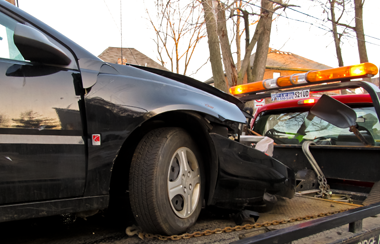 |
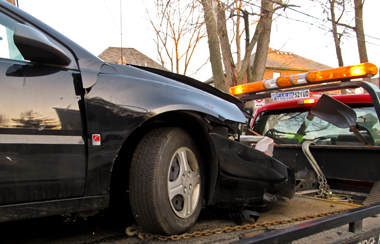 |
|---|---|
| The on-screen images appear to be identical, but are they? Right-click the images and save them to you computer if you want to look for differences. I started with an image that was 3710 pixels wide and 2386 pixels tall. It had a nominal resolution of 240 dpi. Here's how the images above were made: |
|
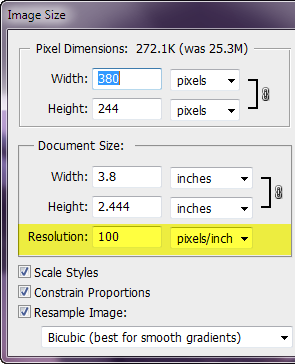 |
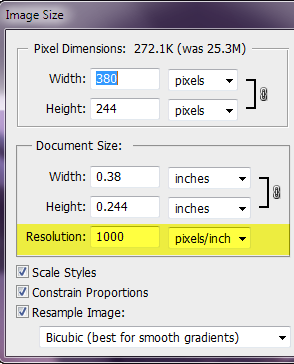 |
| I set the resolution for the 100 dpi image at 100 and then entered 380 for the size of the resulting image in pixels. Note the Document Size width is shown as 3.8 inches. |
I set the resolution for the 1000 dpi image at 1000 and then entered 380 for the size of the resulting image in pixels. Note the Document Size width is shown as 0.38 inches. |
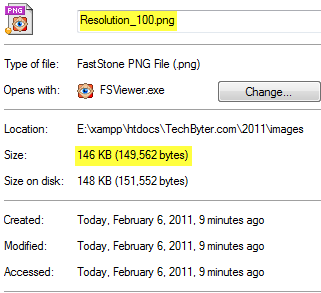 |
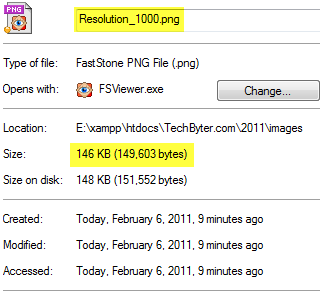 |
| Here are the document properties panes side by side for the two images. It's important to note that both files are approximately the same size even though one is nominally 100 dpi and the other is nominally 1000 dpi. The difference (41 bytes or 3 hundredths of one percent, 0.03%) is unimportant. | |
Nominal Resolution Isn't Resolution
You may already be ahead of me, but I'll explain what's going on here. The two main points are these:
- On a screen, the only thing that matters is dots (pixels).
- On paper, resolution is important, but the printed resolution has no relationship to the nominal resolution specified in the file.
Actual printed resolution depends on just two things:
- The size of the original image in pixels.
- The size of the printed image in inches or centimeters.
When you know the original image size and the print size, finding the resolution involves one easy calculation using either the height or the width (assuming you haven't stretched the image one way or the other, it doesn't matter which):
- Divide number of pixels by size to obtain pixels per inch or pixels per centimeter.
EXAMPLE #1
An image that's 1200 pixels wide, when printed on photographic paper that's 6 inches wide will have a resolution of 1200 divided by 6, or 200 pixels per inch. Easy, right?
Print professionals usually need to work things out the other way, though. If you'll be printing an image 3 inches wide in a magazine that requires a minimum resolution of 240 pixels per inch, how large does the original image need to be in pixels? Again, we're considering just the width here because you can use height, width, or diagonal as long as you haven't changed the image's aspect ratio.
EXAMPLE #2
This time we know the final size that's needed (3 inches) and the required resolution (240 pixels per inch).
The size required for the original image is the printed size times the resolution, 3 inches times 240 pixels per inch, or 720 pixels.
Also easy.
It's Even Easier on the Screen
Screen resolution is essentially fixed. Older CRT screens could handle multiple resolution settings, but the current crop of LCD screens work properly only at their native resolutions. A monitor that shows 1920 pixels in a display port that's 18.5 inches wide has a resolution of 104 pixels per inch. Nominally, screen resolution is often stated at 96 pixels per inch. If you want a nice round number, just use 100 pixels per inch for most monitors.
So if you have an image that's 800 pixels wide, it will be approximately 8 inches wide on most standard modern monitors. The weasel words in that sentence are "most", "standard", and "modern". Devices designed for specialized use will not follow these rules but if you're preparing images for those devices, you probably already know what the rules are.
If you're going to e-mail a photograph for viewing on screen, the width of the image in pixels should be somewhere between 600 and 1000 pixels. The larger the image, the longer it will take for you to send it and the longer it will take the recipient to download it. If you know that most of the people you're sending pictures to have large screens and fast connections, use sizes in the 800 to 1000 pixel range. For those who have slow connections and small screens, use the 600 to 800 pixel range.
How Much Resolution Do You Need?
Here's where the fly does a nose-dive into the ointment. If you don't prepare photographs for publication in print and you never order a photographic print larger than 11 by 14 inches, you can safely ignore everything from this point forward.
Files that are prepared for a printing press go through what's called a raster image process (RIP) that creates a negative or a plate for printing. The press will have specifications for image resolution. For newspapers, the number is often under 100; for high-quality magazines, it might be around 300.
More is not better.
If a RIP that needs a 300 dpi image receives an image that would actually provide 400 dpi resolution, the process will continue normally. But if the RIP that needs a 300 dpi image receives a 900 dpi image, one of two bad things will happen: The RIP will take far longer than it should or the RIP will crash.
A publication specialist might receive an image that's 6000 pixels wide from a professional photographer and this image may be scheduled to print 2 inches wide in the next issue of the Daily Foonblatt, which requires 150 dpi resolution. Now what?
EXAMPLE #3
This, too, is easy enough if you don't allow the numbers to frighten you. If the image needs to be 150 dpi and the width is 2 inches, it should be clear that the image presented to the RIP should be 300 pixels wide.
The problem is that the image is actually 6000 pixels wide. Using an application such as Photoshop, you could dial in the resolution (150 or maybe 200 because using a number that's slightly better than specified is usually beneficial) and then the finished size (2 inches). The image editor application will do the rest.
And it's not much harder if you need to do the math manually: Just calculate the percentage that your desired size (300 or 400 pixels) is of the original size (6000). That would be 0.05 (for 300) or 0.0666 (for 400). Reduce the size based on the percentage and the press operator at the Daily Foonblatt will be delighted.
Numerous other considerations can come into play as images move from the computer to print, including how large an image can be printed from a given digital file. The resolution needed can vary depending on the intended use.
For example, posters you might find at eye level (think office lunchrooms, school bulletin boards, and subway stations) will be printed at relatively high resolution (100 dpi or more) while the image used on a billboard designed for viewing from automobiles from the freeway at 65 miles per hour might have only 10 dpi resolution because people will view these from a considerable distance and distance has an effect on resolution.
All of these considerations apply when you're using a scanner, too, but let's stop while we're ahead. Now go forth and digitize.
PODIOBOOKS.COM: Audio Books for Free
Amazon allows Kindle users to download free books, but so far I haven't found any good free books. I keep trying, though. If you're more interested in audio books, you might find that PODIOBooks.com ("Free serialized audio books, delivered on your schedule") has books you'll enjoy.
The site bills itself as "A place where listeners, authors and creators can come together and take advantage of the social space, all dedicated to what we offer from Podiobooks.com. If you don't think you have time to listen to audio books, think again."
Although the books are free to download, donations are encouraged. "We're delighted to bring you free books," the site says, "but there are real costs associated with the service." Donations are encouraged and authors receive 75% of donations.
The offerings are impressive: From alternative history and audio drama through chick lit, erotica, and historical fiction all the way to thriller, travelogue, and young adult. Some of the works are newly written and recorded by the authors. Others are classics such as The Wonderful Wizard of Oz by L. Frank Baum. In most cases, the narrators aren't the "voice of God" readers that major publishers hire to create audio books. They're just plain folks who read and record books. Sometimes the quality of the recordings is high and sometimes ... well ... let's just say that sometimes it leaves a bit to be desired.
What you won't find is audio books of current best sellers, but you already knew that, didn't you?
Give 65 Below a listen. "After twenty years hunting terrorists under orders to 'render harmless', USMC Master Sergeant Marcus Orlando Johnson, Mojo to his friends, settles into a quiet rural retirement on his childhood home in the Alaskan backwoods. But the idyllic retirement is shattered when Marcus comes across soldiers of America's staunchest enemy who are about to unleash a nightmarish biological weapon on the world from the most unexpected of places." Written and read by Basil Sands, this is a good example of what the system can provide.
 Bottom Line: Creative Commons audio books
Bottom Line: Creative Commons audio books
You may need to search a bit to find some good audio books, but this is a worthwhile experiment that's worth spending some time with.
For more information, visit the PodioBooks website.
Are You Ready for IPv6?
The world is running out of IP addresses. When the Internet was ARPANET, addresses consisting of 4 triads (xxx.xxx.xxx.xxx) seemed more than sufficient. That's 256x256x256x256 addresses. More than 4 billion (4,294,967,296) addresses seems like more than you'd ever need. But then ARPANET became the Internet. Everybody had access. Worldwide. And every phone, printer, and computer needed an address. Help!
What we have now is IPv4, the fourth revision of the Internet Protocol (IP). IPv4 is the most widely deployed Internet layer protocol, but IPv6 will eventually replace it. You may have wondered how much you should be concerned about this change.
IPv6 has longer addresses that look funny. Instead of 129.145.76.204, you might have an address like 2001:0db8:85a3:0000:0000:8a2e:0370:7334. Just looking at that address suggests that you'll have far more options than with IPv4. If that's all that was involved, there would be no problem.
But IPv4 and IPv6 are incompatible. Oops. Problem.
The numbering system is different and how the system works at the hardware level is also different. IPv6 requires both hardware and software changes. If I open a command prompt and type ipconfig, I'll see that my hardware likes IPv6 (I've highlighted the appropriate lines in yellow):

But that's not all. IPv6 also needs software support. June 8, 2011, is World IPv6 Day and that's the day that Google, Facebook, and other Internet big dogs will run a day-long IPv6 test.
The federal government says that all systems should be IPv6-compatible by September 30, 2012. That means web mail, domain name server (DNS), and Internet service provider (ISP) services, must operationally use native IPv6. For the most part, these changes will occur without your help or input. Browsers should be compatible by then (unless you insist on running an antique browser like Netscape) and if your system's hardware and software are reasonably current, you should have no problems.
So you shouldn't need to do anything and for most people this will be a non-event.
Oh, by the way, IPv6 supports approximately 3.4×1038 (340 undecillion) unique addresses, which is deemed to be sufficient for the foreseeable future. (The 38 following 10 is superscripted. If you don't see the superscript, it's 3.4×10^38.)
Short Circuits
Would You Follow a Link to TechByter.nazi?
If you do, you won't find this site and you'll have to wait until sometime in 2012 anyway if the nazi top-level-domain (TLD) is approved and if anybody registers "TechByter" there. This is all part of a plan by ICANN (the Internet Corporation for Assigned Names and Numbers) to create a new series of top-level domains. After all .museum, .mobi, and .jobs have all proved to be so very popular! Of the last batch of new TLDs, only .biz has much of a following.
And the one TLD that makes sense (either .xxx or .sex) is probably the one that won't ever be approved despite the fact that it could be used to create a virtual red-light district that could be used to segregate what some consider to be objectionable content from the rest of the Internet.
Have an idea for a new TLD? ICANN would like to hear from you. When you apply, be sure to include the $185,000 application fee and budget for $25,000 per year per TLD. Some of the proposed TLDs include .eco, .love, .god, .sport, .gay, and .kurd. What about .cat, .dog, .sport, or .music? What if somebody wants .kangaroo or .superman?
If all it takes is money to join the game, the number of possible TLDs could jump sharply. ICANN refers to this process as the Internet land rush, but one could just as easily see it as a cynical way for ICANN to make money. Those who buy the TLDs are assured of obtaining some business, though. The brand managers at large companies will need to buy all of their current trademarks under the new TLDs. Otherwise, somebody who doesn't like the company could buy the domain name and use it to defame the brand.
So there's money in there somewhere.
RIP: Ken Olsen
The engineer's engineer, Ken Olsen, is dead at 84. Olsen founded the Digital Equipment Corporation (DEC), which was once the world's second-largest computer company, second only to IBM. In 1957, Olsen used $70 thousand to create DEC and in the late 1980s DEC had sales of $14 billion. But he made one serious error.
"The personal computer will fall flat on its face in business," Olsen said. DEC had made its fortune by displacing huge and expensive IBM mainframe systems with much smaller and less expensive minicomputers, but Olsen intensely disliked personal computers. In 1992, with the company in serious trouble, DEC's board forced Olsen to resign and in 1998 DEC was acquired by the Compaq Computer Corporation for $9.6 billion.
Digital's minicomputers were huge by today's standards. The series-11 systems generally fit in "high-boy" cabinets with 19-inch-wide racks. But instead of costing millions of dollars, as IBM's systems did, DEC's minicomputers could be purchased for just tens of thousands of dollars. What Olsen missed was the fact that desktop systems (he called them "toys") could be had for thousands, not tens of thousands.
Instead of being the company that led the parade, Digital became the company that tried to maintain the status quo in a business that doesn't like the status quo. Olsen, who is recognized as the father of the minicomputer, could have been the man who led businesses to desktop systems.
After serving in the Navy at the end of World War II, Olsen earned degrees from the Massachusetts Institute of Technology and worked at MIT's Lincoln Laboratory from 1950 until he formed DEC in 1957 with co-worker Harlan Anderson. Ever the engineer, Olsen hired smart people, gave them responsibility, and expected them to perform.
After being kicked out of Digital, Olsen formed Advanced Modular Solutions, but the company failed.


 The author's image: It's that photo over at the right. This explains why TechByter Worldwide was never on television, doesn't it?
The author's image: It's that photo over at the right. This explains why TechByter Worldwide was never on television, doesn't it?
